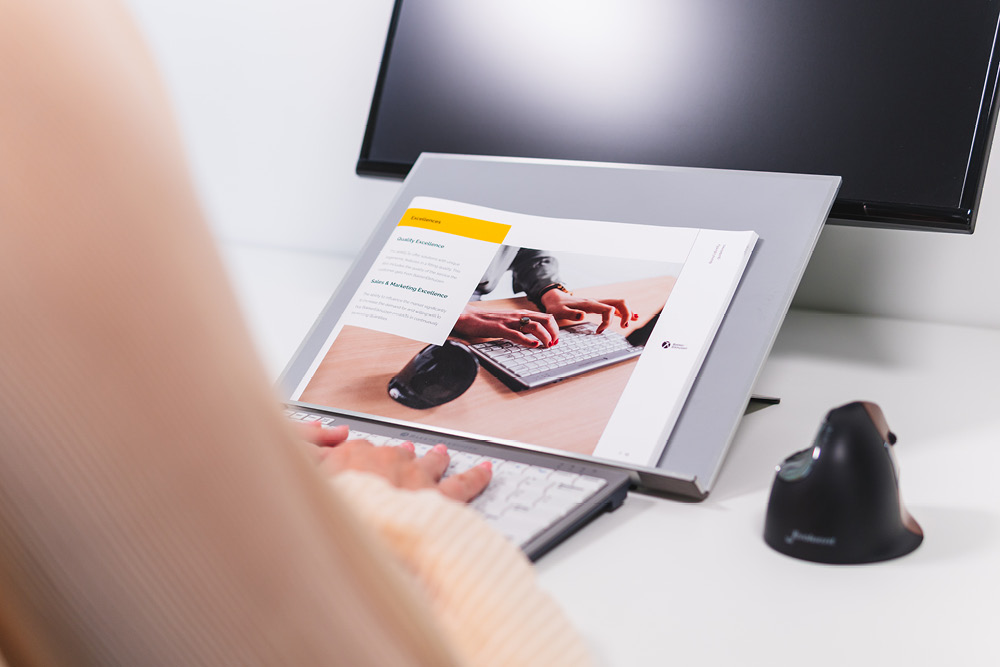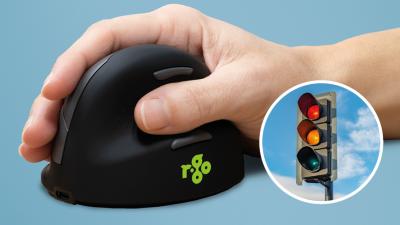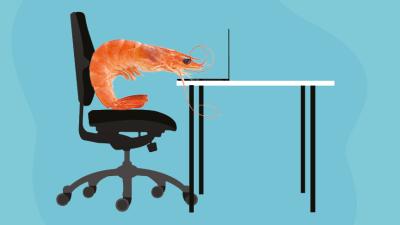Did you know that some of the best ergonomic kit helps you make small changes to the angle that parts of your body are in when working?
These tilts can be crucial to good workstation posture – and help prevent pain.
Let’s look at 10 good examples of the tilt in ergonomic design:
1. An adjustable office chair

When you use an office chair with adjustable height, you can position your hips slightly higher than your knees when sitting. This can help prevent your pelvis from tipping backwards, so keeping a suitable pelvic position and helping to keep your inward lumbar curve.
The most natural position of your pelvis is a neutral position. Think of this as being halfway between:
- the furthest you can tuck your bottom in (a backwards or posterior tilt)
- and the furthest you can stick your bottom out (an anterior tilt).
Remember it’s best to have more adjustments than just the seat height on your office chair.
2. A wedge cushion
The same principle is used in the design of an angled posture support wedge. You can sit on one of these to help support a suitable tilt of your pelvis and more open hip position - giving you a more comfortable sitting position. This might be best used when you’re sitting low on an ordinary kitchen or armchair.
These wedges are incredibly popular with and helpful to people experiencing lower back pain or other pain. Some also have a ‘coccyx cut-out’ which can reduce pressure on the coccyx region at the base of your spine.
3. A sloped document holder
A very simple yet highly effective ergonomic solution for referring to a written document while working on a computer is to pop it in the front of your screen on a document holder. You’ve guessed it – it’s tilted! Use fewer head and neck movements than you would if your document was flat on the desk and/or to your side.
“I am a bit of an addict of the Document Slope!” writes Mary in her review. “I recommend them to members of staff who work from books or have neck problems from twisting sideways to make notes on a book while also using the keyboard.”
4. A laptop riser
Here’s a tilt which works in a different way. The angled surface of a laptop stand supports the back of your laptop keyboard to tilt it upwards. The result? Your laptop screen is now at a more ergonomic viewing position in front of you, and you’ll no longer hunch to look down. A wise move!
Get a separate mouse and keyboard to complete your setup and you’re sorted.
5. A tilting footrest
Ergonomic product designers haven’t neglected your feet when considering how to make us happier and healthier at work. Many footrests for under your desk are tilted to help you find a comfortable, supported and angled position. Want to point and flex your feet while you work too? Choose a footrest which you can move with your feet, to increase circulation in your legs. A rocking feature also aims to reduce leg fatigue.
6. A keyboard with a slight tilt
DSE regulations for employers for your use of Display Screen Equipment state that your keyboard should be tiltable. Whether you like having the keyboard with a small tilt is personal preference – and many people prefer their keyboard to be flat – but it’s good to have that option. Your keyboard might have little legs under it, or pads to stick on, to enable this.
Find the sweet spot where your wrists feel in a comfortable position for your typing posture and you can see the keys clearly if you’re not a touch typist.
Some people like a slight negative tilt on a keyboard, so the front is higher than the back, and say they find it helps with a relaxed wrist position.
7. An office chair with a recline tilt
An ergonomic office chair with a movement mechanism allows your body to go through its range of motion - which is very healthy and promotes circulation.
A recline tilt on your chair’s backrest helps to reduce the pressure on your discs and muscles when sitting, allowing you to relax and reduce the strain on your back.
There is more than one tilt type in ergonomic chair design; one tilt that pivots from the central point under the seat and your feet will come off the floor when you recline. The other is a knee tilt where the pivot is closer behind the knees, your feet don’t lift much from the floor, and your back and head will descend more than a central pivot. You’ll retain support while enjoying some movement.
8. An upright mouse
Most ‘upright mice’ are not 100% upright, because they have a subtle tilt on them to give support to your hand.
An upright or vertical mouse encourages your hand into a more neutral and comfortable 'handshake' position, with the delicate part of your wrist not touching your desk. “A really good product and it’s stopped my arm pain” was one customer’s short but conclusive review of the Posturite Penguin Mouse.
9. A monitor arm
You can tilt your screen as well as move it up and down with an ergonomic monitor arm. Don’t underestimate how useful a desk accessory like this can be for your posture, wellbeing and comfort.
10. An ‘active sitting’ chair
You’ll see in the photo just how integral angles are to the design of a kneeling chair. One seat is angled forwards to position the pelvis in a natural position with an open hip angle. Kneeling chairs that have a rocking seat are examples of active sitting chairs and are best for longer usage.
The product designers of the Capisco chair for ‘active sitting’ have included a useful adjustable backwards tilt in certain models. The Capisco chair is often recommended by ergonomists instead of a kneeling chair as it offers good positioning, movement and comfort while providing support.
You can now see how ergonomists and product designers tend to love a tilt. Let’s make the most of all the ingenious solutions out there for us to enjoy in ergonomics.
And as Frank Sinatra once said “Cock your hat – angles are attitudes.”
Read next:




















